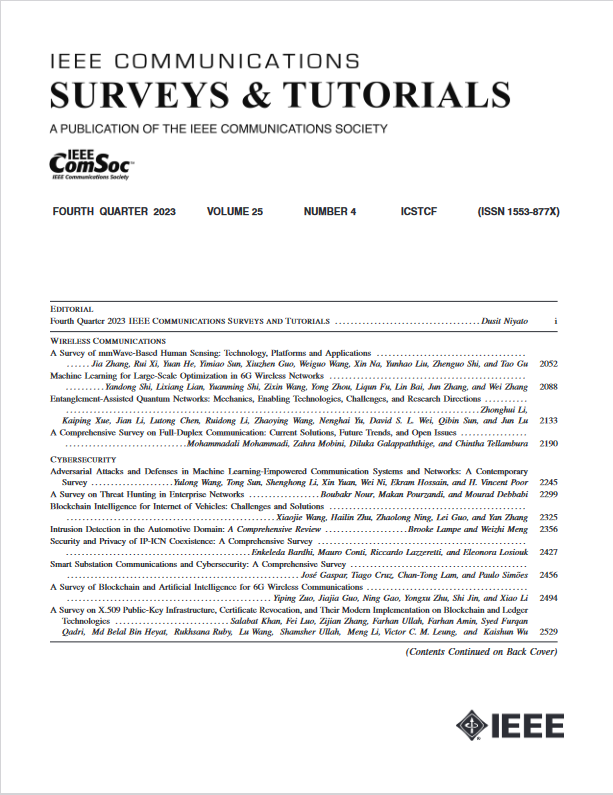去中心化联邦学习:基础、现状、框架、趋势和挑战
IF 34.4
1区 计算机科学
Q1 COMPUTER SCIENCE, INFORMATION SYSTEMS
引用次数: 37
摘要
近年来,联邦学习(FL)在不共享敏感数据的情况下训练协作模型方面取得了重要进展。自其诞生以来,集中式FL (CFL)一直是文献中最常见的方法,其中一个中心实体创建一个全局模型。然而,集中式方法会由于瓶颈、系统故障的高脆弱性以及影响负责全局模型创建的实体的可信度问题而导致延迟的增加。分散式联邦学习(Decentralized Federated Learning, DFL)的出现是为了通过促进分散式模型聚合和最小化对集中式体系结构的依赖来解决这些问题。然而,尽管在DFL方面做了很多工作,但文献并没有(i)研究区分DFL和CFL的主要方面;(ii)分析DFL框架,以创建和评估新的解决方案;及(iii)检讨使用DFL的应用场景。因此,本文从联邦体系结构、拓扑、通信机制、安全方法和关键性能指标等方面确定并分析了DFL的主要基础。此外,本文还探讨了优化关键DFL基础的现有机制。然后,对当前DFL框架最相关的特征进行了回顾和比较。然后,分析最常用的DFL应用场景,根据前面定义的基础和框架确定解决方案。最后,研究了现有DFL解决方案的演变,以提供趋势,经验教训和开放挑战的列表。本文章由计算机程序翻译,如有差异,请以英文原文为准。
Decentralized Federated Learning: Fundamentals, State of the Art, Frameworks, Trends, and Challenges
In recent years, Federated Learning (FL) has gained relevance in training collaborative models without sharing sensitive data. Since its birth, Centralized FL (CFL) has been the most common approach in the literature, where a central entity creates a global model. However, a centralized approach leads to increased latency due to bottlenecks, heightened vulnerability to system failures, and trustworthiness concerns affecting the entity responsible for the global model creation. Decentralized Federated Learning (DFL) emerged to address these concerns by promoting decentralized model aggregation and minimizing reliance on centralized architectures. However, despite the work done in DFL, the literature has not (i) studied the main aspects differentiating DFL and CFL; (ii) analyzed DFL frameworks to create and evaluate new solutions; and (iii) reviewed application scenarios using DFL. Thus, this article identifies and analyzes the main fundamentals of DFL in terms of federation architectures, topologies, communication mechanisms, security approaches, and key performance indicators. Additionally, the paper at hand explores existing mechanisms to optimize critical DFL fundamentals. Then, the most relevant features of the current DFL frameworks are reviewed and compared. After that, it analyzes the most used DFL application scenarios, identifying solutions based on the fundamentals and frameworks previously defined. Finally, the evolution of existing DFL solutions is studied to provide a list of trends, lessons learned, and open challenges.
求助全文
通过发布文献求助,成功后即可免费获取论文全文。
去求助
来源期刊

IEEE Communications Surveys and Tutorials
COMPUTER SCIENCE, INFORMATION SYSTEMS-TELECOMMUNICATIONS
CiteScore
80.20
自引率
2.50%
发文量
84
审稿时长
6 months
期刊介绍:
IEEE Communications Surveys & Tutorials is an online journal published by the IEEE Communications Society for tutorials and surveys covering all aspects of the communications field. Telecommunications technology is progressing at a rapid pace, and the IEEE Communications Society is committed to providing researchers and other professionals the information and tools to stay abreast. IEEE Communications Surveys and Tutorials focuses on integrating and adding understanding to the existing literature on communications, putting results in context. Whether searching for in-depth information about a familiar area or an introduction into a new area, IEEE Communications Surveys & Tutorials aims to be the premier source of peer-reviewed, comprehensive tutorials and surveys, and pointers to further sources. IEEE Communications Surveys & Tutorials publishes only articles exclusively written for IEEE Communications Surveys & Tutorials and go through a rigorous review process before their publication in the quarterly issues.
A tutorial article in the IEEE Communications Surveys & Tutorials should be designed to help the reader to become familiar with and learn something specific about a chosen topic. In contrast, the term survey, as applied here, is defined to mean a survey of the literature. A survey article in IEEE Communications Surveys & Tutorials should provide a comprehensive review of developments in a selected area, covering its development from its inception to its current state and beyond, and illustrating its development through liberal citations from the literature. Both tutorials and surveys should be tutorial in nature and should be written in a style comprehensible to readers outside the specialty of the article.
 求助内容:
求助内容: 应助结果提醒方式:
应助结果提醒方式:


